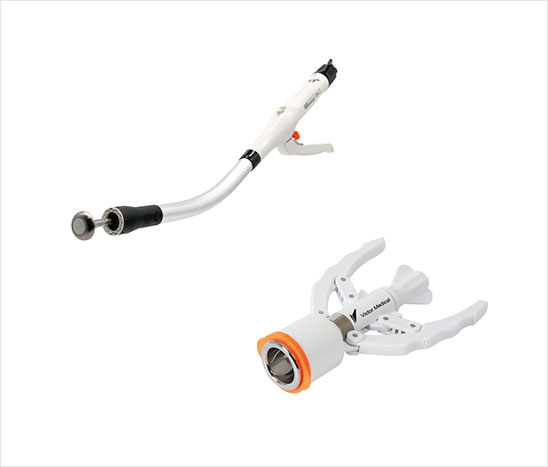
First of all, let's learn about the development history of surgical staplers, one of the most important medical surgical instruments today.
As early as the early twentieth century, foreign experts started to develop the stapler, but due to the bulky instruments, and time-consuming loading and unloading, the large volume can not be used in clinical. With the continuous exploration and improvement of experts, the stapler is getting closer to clinical application.
The surgical stapler (Auto Suture) that was really widely used in the clinic was invented by the American Surgical Corporation (USSC) in the 1960s. In 1967, a brand new kind of surgical staplers, the Liner stapler TA (Thoracic-AbdominaI) was first introduced. Another new operation stapler, the Linear cutter GIA (Gastro-lntestin Anastomosis) was first introduced in 1968. The EEA circular stapler (End-End Anastomosis) was first introduced in 1978, and this new invention of the operation stapler created a milestone in the history of modern surgery. Then, in the late 1970s, surgical stapler manufacturers in China's major cities including Jiangsu, Shanghai, Beijing, and Hangzhou have begun to design and manufacture gastrointestinal staplers. In the early 1980s, the USSC (United States Surgical Corporation) of the United States introduced a new generation of disposable surgical plastic stapler, which has been widely used in clinical practice.
The working principle of various surgical staplers is similar to the book stitcher, so it is generally called STAPLER. It fires two or three rows of interlaced staples into the tissue to cross-stitch the tissue. The nail forming effect is good and it is B-shaped
The main components of the stapler are staples anvil, cartridge, staple driver, firing handle, positioning needle, knob, and marking ruler.
| Name | Features | Application |
| TA (Thoracic-AbdominaI) Single Use Linear Staple | Straight line suture tissue , can not be cut, need the operator to manually cut | Digestive tract reconstruction and closure of stumps or incisions during liver resection. |
| GIA (Gastro-lntestin Anastomosis) Single Use Linear Cutting Staple | The cutting and stitching work can be completed at the same time; the larger opening helps to adjust the position; there are different types and lengths of staple cartridges, suitable for different needs. | Various gastrointestinal, intestinal side-to-side anastomosis, split lung, partial lung resection |
| ENDO GIA (Endoscopic Gastro-lntestin Anastomosis ) Single Use Endoscopic Linear Cutting Stapler | It is suitable for the operation of closing and cutting under the endoscope, and the reload can change the direction. | Under gastroscopy, the gastrointestinal tract and the intestinal tract are closed, and side to side anastomosis and other operations. |
| EEA (End-End Anastomosis) Single Use Circular Stapler | There are many types of circular stapler. Choose according to the diameter of the intestinal tract during surgery | End-to-end anastomosis of gastrointestinal and esophageal surgery |





The application of surgical staplers has brought great convenience to surgical operations. On the whole, various staplers are simple, easy to operate, safe and reliable, but if used improperly, it will also cause the operation to fail and cause unnecessary trouble.
In the course of use, the surgeon should master the basic working principle of stapler, be familiar with the structural performance of various types of stapler, master the correct operation method, and strictly abide by its operation rules and use skills.
For example, when using it, pay attention to the correct placement of the tissue; the operation should be stable; after the firing, check the hemostasis of the incision and the nailing status.
Surgical staplers have many advantages and are now recognized by surgeons. Due to its advent , the original surgical field is narrow, deep, and difficult to manually suture and anastomosis. It also shortens the operation time and reduces surgical complications.
All in all, the correct and reasonable use of the stapler is the key to the success of the operation and the prevention of complications. In order to improve the application level of the stapler, the surgeon must master the correct use method and better serve the patient.
In the end, we hope as a medical instruments manufacturer, we will keep our original intention, try our best to provide the best products and service to the clinic.
[1] Lilac Garden General Surgery Channel,Tian yulong, 2019.12.29
[2] Long-term anti-inflammatory efficacy in intestinal anastomosis in mice using silver nanoparticle-coated suture.[J]. Liu Xuelai,Gao Peng,Du Juan,Zhao Xin,Wong Kenneth K Y. Journal of pediatric surgery. 2017(12)
[3] [On the problem of the suture in gastrointestinal anastomosis].[J]. NAPALKOV P N. Khirurgiia.
[4] [Arterial non-suture anastomosis with a fibrin ring].[J]. FIRT P,HEJHAL L,STERBA O,BEDNARIK T. Rozhledy v chirurgii : mesicnik Ceskoslovenske chirurgicke spolecnosti. 1958(4)
[5] Sutureless Intestinal Anastomosis with a Novel Device of Magnetic Compression Anastomosis [J]. Chinese Medical Sciences Journal. 2011(03)